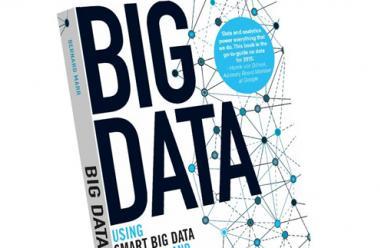Unsurprisingly, from an author with a background in performance management, Bernard Marr’s Big Data focuses on how to reap the benefits of the large volumes of data that are now available to marketers.
The book is rich with examples of how the sheer size and level of detail of data available means that traditional ways of dealing with it are no longer applicable. In one remarkable example of the new kinds of analysis the author tells of a “Genes in Space” computer game. This game used DNA from tumour samples to construct a 3-D space of stars and galaxies. Each time the game was played, a DNA sample was mapped. Over a period of just one month, 1.5 million games ran. They mapped as much DNA as 125,000 non-stop man-hours in the lab.
That said, this work is not a starry-eyed tribute to the Big Data future, nor is it a manual from which to learn how to run multiple regressions or machine-learning algorithms. It is much more practical than that.
Marr begins with a new rendition of the SMART acronym. His contention is that “You can’t identify your information needs if you are not clear about your strategy”. Accordingly, the S stands for strategy, and the author combines ideas from Michael Porter’s value chain model, the Business Model Canvas, and Kaplan & Norton’s
Strategy Maps to construct a SMART Strategy Board. This is a tool whereby a business view can be created that specifies what questions need to be asked and consequently what data is needed to answer them. The author is very clear that Big Data is not an invitation to a fishing expedition. Quite the reverse. It is a cornerstone of proactive management.
Continuing with the SMART acronym, the remaining letters describe subsequent steps in the business process: Metrics & Data, Analytics, Reporting, and Transformation, with each step earning its own chapter in the book. Each chapter is packed with examples, cases, and statistics from every field imaginable. In addition to straightforward business examples, there are some from Medicine, Engineering, Social Media, Journalism, Meteorology, Politics, and even the Internet of Things, to name a few.
The Metrics & Data chapter classifies the different kinds of data in a number of different ways. For example, is it internal or external, is it structured or unstructured, how was it collected? In each case the reader is prompted to envision its usefulness within the context of SMART. I would have liked to have seen more discussion of the uses for real-time data, and not just geolocation feeds from computers and phones but also from social media sources like Twitter. We do have a brief reminder in the book’s Conclusion: “by the time people realize just how much data is out there about them it’s going to be too late”.
A heavy emphasis towards the analysis of unstructured data gives the Analytics chapter the scope to describe the technologies used according to how they are applied and the results delivered, rather than descending into the world of algorithms or machine learning, and this certainly makes for a better read. A story I know well, the Gatorade Mission Control room, was excellently told while that of Brooklyn’s exploding manholes was new to me! Issues like consent and transparency are also visited in this chapter, and the risks to privacy that arise when data from multiple sources are analysed together with respect to an individual who may not be aware that they have consented to that use of their behavioural data.
For me, a big drawback of the Reporting chapter is the monochrome rendition of some truly superb infographics. Fortunately, URLs are provided for linking to the originals, and this is particularly good for the graphics that have animations, like Mike Bostock’s fabulous D3. Marr correctly emphasises that creating an image that represents analysed data accurately and compellingly is a role for a specialist and not necessarily something that should be the responsibility of the Data Scientist that did the analysis.
Finally, the T in SMART is for business Transformation. For every Strategy question answered, there must be an action. The ultimate validation of the answered question is when taking action on it improves the business. Every anecdote in this chapter describes an example of where Big Data is being used to improve businesses by increasing understanding of customers or improving performance, or to improve people’s well-being by improving health or the environment.
Overall this book is an excellent introduction to the changes we are seeing in business as a result of Big Data and a worthwhile read for any serious marketing leader.
Sandra Pickering is Founding Partner of opento.com a brand consultancy specialising in applying psychology to brand strategy and all aspects of brand-building.
Read more from Sandra and opento in our Clubhouse.
Newsletter
Enjoy this? Get more.
Our monthly newsletter, The Edit, curates the very best of our latest content including articles, podcasts, video.
Become a member
Not a member yet?
Now it's time for you and your team to get involved. Get access to world-class events, exclusive publications, professional development, partner discounts and the chance to grow your network.

